|
Writing / Photography: Su-yi Lin
What is your first impression of Tamsui (淡水)? The answer might be the river, the golden sunset, traditional local snacks like Iron Eggs (Iron-hard preserved egg) or Fish Balls, some western-style buildings such as Hongmao Cheng (also named Fort San Domingo紅毛城,又名聖多明哥城), which was built by Spanish and Dutch people in the 17th century, or Dr. George Leslie Mackay (馬偕博士), who was the first Presbyterian missionary and had great impact on Tamsui.
The above answers do not surprise us at all because Tamsui is a popular tourist spot and a historical town. Since the Qing Dynasty, it had been an important northern harbor because it is located at the outlet of the Tamsui River. However, tourists may not know that Tamsui is not only a riverside area but also a mountain town. If someone would like to explore, read, and experience the real old streets and ancient alleys in Tamsui, he should not miss going to the Chongjian Street (重建街), which is well-known as ‘the First Old Street in Tamsui (淡水第一街)’.
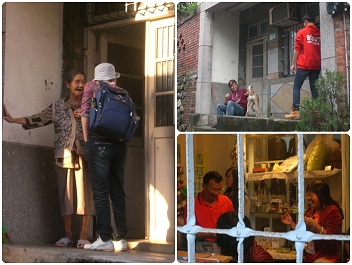
Chongjian Street, a friendly old street in Tamsui near Taipei
Background
Wandering on the Zhongzheng Road (中正路), tourists can see an ordinary alley next to the wall of the Fu You Temple (福佑宮). This is the entrance of the Chongjian Street. The street is winding, about 550 meters in length. Its old name Jiu-kan Street (九崁街) literally means nine shops in Taiwanese, in order to memorize that the street was developed from nine shops. Moreover, ‘kan’ indicates stairs in Chinese, so the old name also implies that the ground level of the Chongjian Street is not flat. The difference between the highest and the lowest is obvious. Street houses are built with the landforms.
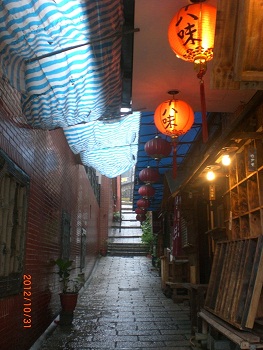
The entrance of the Chongjian Street, an ordinary alley next to the wall of the Fu You Temple
From the end of the 19th century to the mid-20th century, the Chongjian Street became prosperous owing to its location. While foreigners and businessmen went to the riverside area because of the Tamsui Harbor, the Han people who made a living by agriculture migrated to upper areas. Over time, an invisible line between the foreigners’ and the Hans’ residential areas appeared. The entrance of the Chongjian Street was regarded as a city gate although Tamsui did not have any city wall. More and more famous or wealthy Han people moved to the Chongjian Street because it was close to the downtown. For example, the famous writer Chang-xiong Wang (王昶雄) lived in the No. 30 street house. Tang-pan Gao (高湯盤), the first general manger of Hua Nan Bank (華南銀行) from Tamsui, lived in the No. 127 street
house.
The Profile of Chongjian Street Community, New Taipei City, Taiwan
Length of Street: 500-600 meters
Household: around 200 households
Participators of Community Empowerment and Development: Tamsui Culture Foundation (淡水文化基金會), Jiu-kan Community Development Association (九崁社區發展協會), Tamsui Community University (淡水社區大學), Department of Architecture at Tamkan University (淡江大學建築系), Association for the Development of Tamsui Street Culture (淡水鎮街道文化促進會), etc.
Rescue of Chongjian Street
According to the first urban planning in 1968, the government intended to totally or partially pull down or remove some houses in the Chongjian Street for a wide road leading to Tamsui Qing-shui Temple (清水巖), one of the largest local faith centers. The urban plan was not implemented until 2001. However, after over 30 years, the original plan was mistimed.
The community representatives against the plan proposed three issues. First, the government planned to build a viaduct above the houses which house numbers were smaller than 32. These residents would be forced to face the drawbacks like poor natural light, air pollution, and noise. Second, some of the street houses with odd house numbers were built on a steep slope. The construction would be very dangerous. Third, the wide road did not connect with the boulevards in Tamsui. If the road was primarily used by the tour buses to the Tamsui Qing-shui Temple, there was no space for parking.
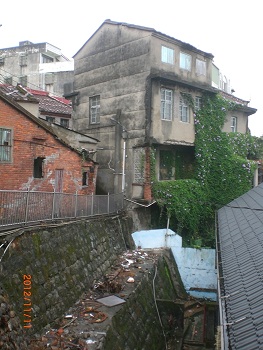
The street houses were built on a steep slope.
For the rescue of the Chongjian Street, from 2001 to 2010, a series of workshops, seminars, and public hearings were held to educate the community residents or to communicate with the public sectors by the Tamsui Culture Foundation, the Jiu-kan Community Development Association, the Tamsui Community University, and the Department of Architecture at Tamkan University. The milestone in this stage was the preservation of four historic buildings: the Old House of Shi’s Family (施家古厝) in 2005, the Japanese Police Quarters (日本警官宿舍) in 2007, the No. 14 Street House (14號街屋) and the No. 16 Street Houses (16號街屋) in 2009. Owing to these historic buildings protected by Cultural Heritage Preservation Act (文化資產保存法), the forepart of the Chongjian Street was not able to be under construction.
In May 2010, the photographer Xu Zhong Cheng (程許忠) initiated an activity ‘Stand Up for Chongjian Street (站滿重建街)’ on Facebook. As Mr. Cheng is the descendant of the residents living in the Xu Shun Ji Old House (許順記古厝), the No. 8 and No. 10 street houses, he invited Internet users to keep the memory of the old street together with him. On 30 May 2010, thousands of people attended there to express their support. The nonviolent protest against the widening of the Chongjian Street was widely reported in media.
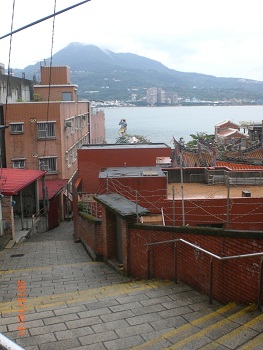
The gathering location of the activity ‘Stand Up for Chongjian Street’
Due to public pressure, the New Taipei City Government finally announced their three-phase project: For the street houses which house numbers were larger than 30, the street widening plan continued. For the house which numbers were between 14 and 30, the plan was postponed. For the houses which numbers were smaller than 14, the plan was cancelled. Furthermore, the government agreed to pay more attention to the repair and reuse of the Old House of Shi’s Family as well as the historic district preservation of the Hans (漢人歷史街區保存計畫).
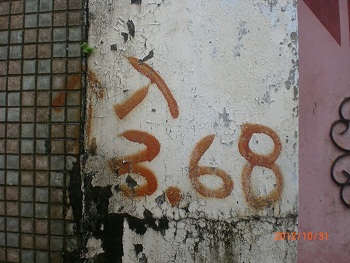
A mark left by the public sector due to the street widening plan
Rejuvenation of Chongjian Street
The street widening plan was led by the Public Works Department (工務局), rather than the Cultural Affairs Department (文化局). Consequently, the process focused on construction issues such as the blacktop, underground cables, or the roadside safety for parallel parking. No cultural images discussed in the previous community workshops were embedded in the new road. Thank to local volunteers, the development and rejuvenation of Chongjian Street Community could keep going.
In June 2011, Mr. Xu Zhong Cheng restarted the Chongjian Street Creative Market (重建街創意市集), sponsored by the Tamsui Qing-shui Temple for the tents. The creative market had been an annual project managed by the Tamsui Culture Foundation from May 2009 to June 2010. Its original objective was to promote the history and culture of the Chongjian Street. However, the restart of the creative market does not carry much baggage from the past. Due to the shortage of funding and man power, it becomes a monthly activity every second weekend, except for rainy days.
In October 2011, the Association for the Development of Tamsui Street Culture took over the creative market. With the support from community volunteers and the young generation studying or living in Tamsui, its new vision is to link the community, the cultural creative workers, and the tourists. The voluntary team regularly has meetings in the No. 14 Street House, also named Herbs Maison (香草街屋). As the host Allen Tsai (蔡以倫) worked in print media, and most of the core volunteers are freelancers, copy writers, or actors during the day, the type of the creative market becomes more like an event, instead of a market.
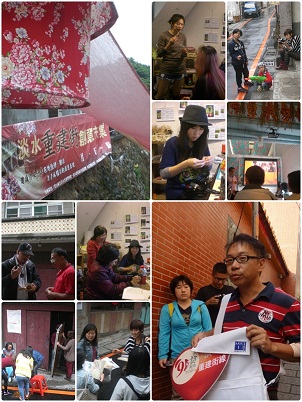
The voluntary team and street vendors of the Chongjian Street Creative Market
In April 2012, the voluntary team created a ‘virtual’ school – the Chongjian Elementary School (重建國小). They associated the historic spots and their stories in the neighborhood of the Chongjian Street with the buildings on campus. Hence, the surrounding lanes of the Fu You Temple are the school playground. No. 14 Street House is the household management classroom and the tuck shop. The Café in the Red Castle (紅樓), established in 1899, is the restaurant. Tourists can visit the school based on its campus map or tour guides.
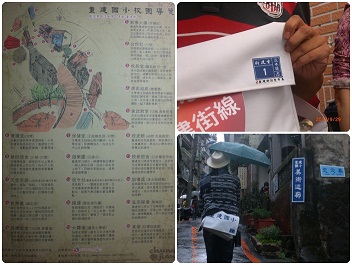
The campus map and school bag of the Chongjian Elementary School
In the future, the Chongjian Street Community has two good bases for its development: an informal but effective communication channel with the public sector as well as the passion and energy of the volunteers. Although it is difficult to find a Chongjian Street guidepost on the boulevards in Tamsui, and no flysheet or brochure related to the Chongjian Street is offered in Tamsui tourist centers, at least, local community representatives can voice their opinions in the Cultural Tamsui Community Newspaper (文化淡水社區報), issued by the Tamsui Culture Foundation.
In addition, the passion and energy of the volunteers has changed the street. Now, not only the tourists and street vendors enjoy the Chongjian Street Creative Market, but also the aged men and women walk out to encourage or chat with the young people in the market. The biggest challenge of the voluntary team is how to be financially responsible for profits or losses. The Association for the Development of Tamsui Street Culture is a grass-rooted organization without plenty funding. The volunteers have no pay for their devotion of time and money. Hopefully, they will quickly find their way in the cultural tourism industry or the cultural creative industry.
| 









